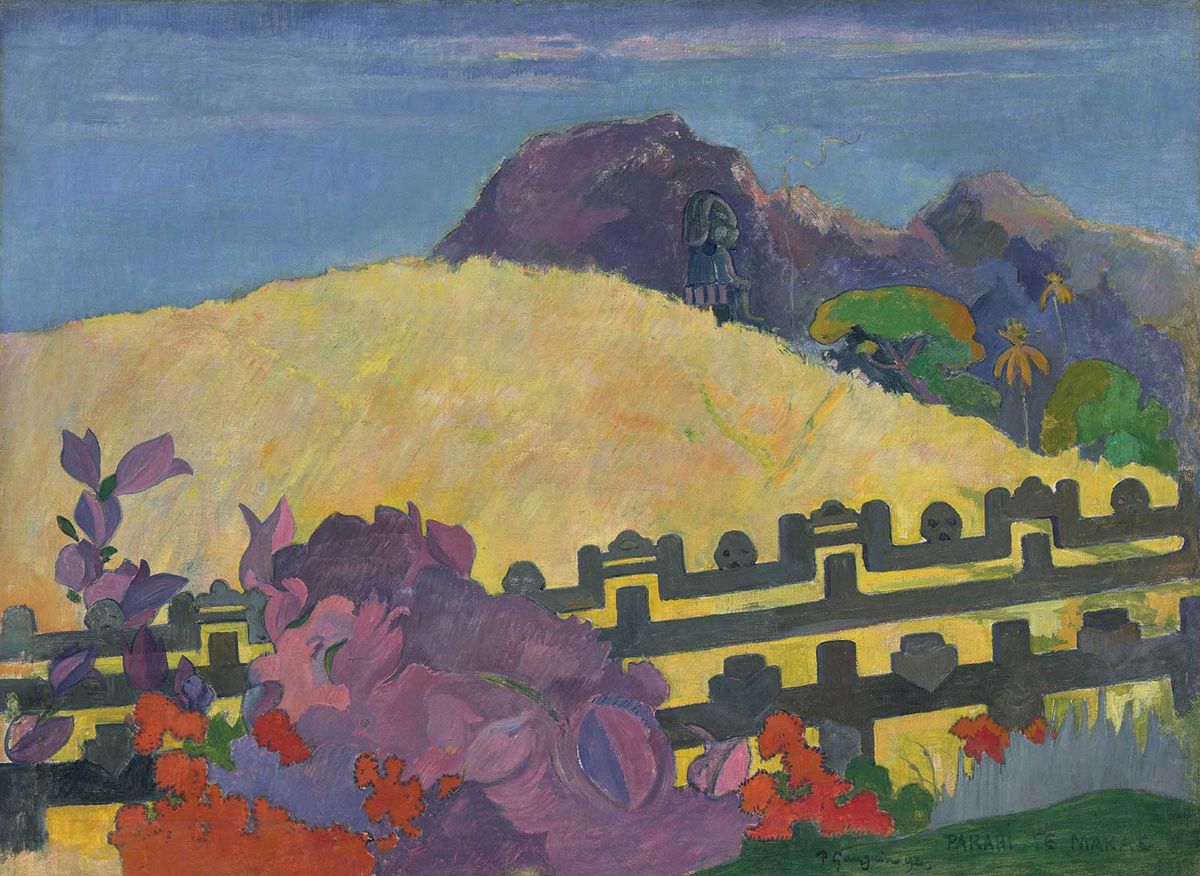A vast survey exhibition devoted to the French Post-Impressionist artist Paul Gauguin has opened at the National Gallery of Australia, Canberra. It is a survey in more ways than one, given that the exhibition’s starting point is Gauguin’s pain-beleaguered final months spent in self-imposed exile in paradise. For Gauguin, it was a strange kind of Eden. He died on 8 May 1903 in the village of Atuona on Hiva Oa, a lush Marquesan island in French Polynesia. He was riddled with syphilis and severe eczema and racked with pain from a broken leg that would not heal.
The exhibition is curated by Gauguin’s countryman, the former director of the Musée du Louvre, Henri Loyrette, and titled Gauguin’s World: Tōna Iho, Tōna Ao. In the language of Tahiti, where Gauguin lived for two stretches (1891-93 and 1895-1901) before arriving in the Marquesas Islands in September 1901, the subtitle refers to Gauguin’s soul, spirit, thought and opinions as well as what constituted his world.
From the mountainous heights of picturesque Hiva Oa, the show looks back at the artist’s earlier life. It traces Gauguin’s friendship with Camille Pissarro, the so-called father of Impressionism who took the younger man under his wing, and maps the artist’s path through the conventional salons and galleries of Paris to his departure from Europe in search of new motifs and greater authenticity among indigenous peoples.
Tahitian titles
Loyrette visited Tahiti in the process of curating the exhibition, meeting with Polynesian and Tahitian scholars and writers. The catalogue for the exhibition includes new information of Gauguin’s use of the Tahitian language for the titles of his works.
Tahitian and Marquesan objects, on loan to the exhibition, include a carved bone-and-shell earpiece whose distinctive geometrical pattern can be recognised in the composition of some of Gauguin’s paintings including The Sacred Mountain (Parahi Te Marae) (1892), on loan from the Philadelphia Museum of Art. The earpiece is on loan from the Musée du Quai Branly in Paris.
The exhibition, five years in the making, is a collaboration between the National Gallery of Australia, Art Exhibitions Australia and the Museum of Fine Arts (MFA), Houston, where it will travel to later this year. It is the first major Gauguin retrospective to be shown in Oceania, the region where the artist’s fiery life burnt out.
There are 140 works of art drawn from more than 65 public and private collections, including many of Gauguin’s best-known paintings such as Young Wrestlers (1888) from the Louvre Abu Dhabi; Portrait of the Artist with the ‘Yellow Christ’ (1890-91) and Femmes de Tahiti (1891) from the Musée d’Orsay in Paris; The Moon and the Earth (1893) from the Museum of Modern Art in New York; and Three Tahitians (1899) from the National Galleries of Scotland. Loyrette’s art-world status no doubt reassured lenders who might otherwise have been reluctant to send their Gauguin treasures to the southern hemisphere.
The artist’s drawings, engravings, sculpture and decorative arts pieces are also on view.
“It’s especially exciting to bring a Gauguin exhibition to the South Pacific which was a region of great importance to him and obviously just a paradise for him and an obsession for him,” says the MFA Houston director Gary Tinterow, who has been integral to preparations for the exhibition.
Tinterow highlights the influence Gauguin had on Vincent van Gogh, on the so-called Nabis (Émile Bernard, Pierre Bonnard, Édouard Vuillard, and others) and on later artists such as Henri Matisse and Pablo Picasso, as well as the German Expressionists. “They would not have made what they made without having seen and attempted to grapple with the import of what Gauguin did,” Tinterow says.
Gauguin has recently been coruscated for his relations with young women and girls in Oceania. Tinterow says that no one associated with the exhibition is calling Gauguin a hero. But his position is that art museums are not the keepers of public morals. In adopting a rigidly dismissive stance, scholars and the public lose a chance to gain a nuanced understanding of earlier times and other places.
“Gauguin may be criticised for his conduct, and one can fairly do so,” Tinterow says. “But we’re not making an exhibition about Gauguin the promiscuous sailor in the South Seas. That’s not the subject of the exhibition. The exhibition is about the extraordinary art Gauguin the artist made in Europe, the Caribbean and Polynesia.”
• Gauguin’s World: Tōna Iho, Tōna Ao, National Gallery of Australia, Canberra, until 7 October; Museum of Fine Arts, Houston, 3 November-2 February 2025


